Santorini Local Products

The most gastronomic place to be in all of Greece (outside Athens) sits upon the rim of a volcano. Do you know the definition of the word "unique"? If you want to comprehend what Santorini's Cuisine is, which word describes it most accurately, you should ignore all the limits of this definition. Multiply it, enlarge it as much as you can and then double it and you'll grasp what Santorini's cuisine is.
Am I a bit over the top? Maybe I am. But Santorini's cuisine deserves that much. Which is why we're going to focus on it now, starting with its local products.
Santorini Capers
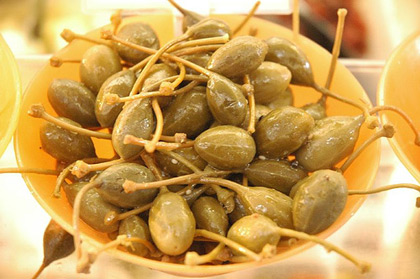
The caper flowers are the summer 'roses' of the Mediterranean. You can see them hanging from the southern crevices of the Caldera rock and from the white-washed walls of old Cycladic houses.
Capers are mostly used to spice a variety of dishes and sauces, due to their rather small size and particular taste. You can collect them in May, June and July. They are collected when they are still the size of a small bean and they are placed in fresh water for 10 days. If you want to turn them sweeter, you should change the water often. Subsequently, the capers are placed in a solution of vinegar and salt and sealed in air-tight glass jars. Pickled capers are good for 10 days.
The caper buds are unique, offering a piquant taste and freshness even when they are dried. That's why they are so extensively used in the local cuisine of Santorini.
Split Peas Puree: fava
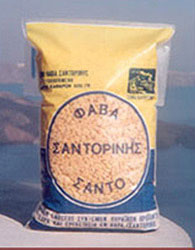
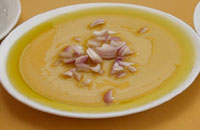
Favus: that's how fava beans were called in Latin and that's where the word fava originates from.
The split-peas of Santorini are famous all over Greece. Why is that? Well, first of all, they are delicious when pureed. Plus, they cook pretty fast. The split-peas are a basic ingredient of many other dishes; the yellow puree that you get when you boil them marries really well with tomato sauce, capers, onions, meat, octopus and herbs like mint and parsley.
The split-peas are quite expensive, due to their advantage in cooking, amazing taste and flexibility in a variety of recipes.
Chlorotyri (cheese)
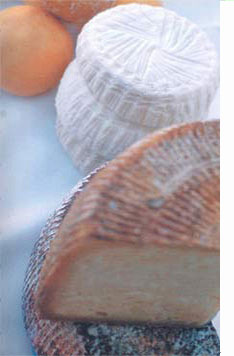
This is a local cheese variety of very limited production, which you will not find anywhere else in Greece. It is a white, creamy cheese with a tinge of sour taste. It's made from goat's mild and can be spread on slices of bread or mixed in the Santorini salad (which also includes cherry tomatoes, rusks, lettuce and anchovies).
White Aubergine
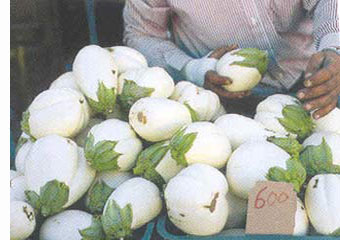
A unique vegetable with alabaster look and excellent taste. We all know that aubergine has a somewhat purple color. But Santorini breaks that rule! The white aubergine of Santorini is surprisingly sweet, with very few seeds. You can slice it and fry it or chop it up raw in salads. It doesn't absorb much oil when it's fried.
Apochti
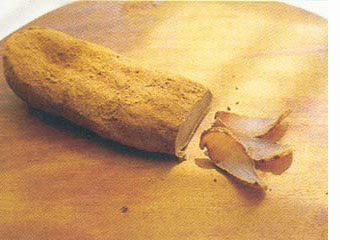
Apochti is the center loin of pork. When processed or cured, this pork can be used in recipes several days later. To use it, you have to first clean it and rinse it well under tap water and then sprinkle it with salt and let it stand to drain for 2 hours. Consequently, you can soak it in vinegar for three days, then strain it and cure it by treating it with ground cinnamon, placing it in a strainer for six hours, then treating it with savory (chopped) and letting it rest for another six hours and finally treating it with a mixture of black pepper and a little cinnamon and letting it rest for another six hours. When the meat hardens a little after you let it air-dry, you'll know it's ready for use.
Santorini Cherry Tomatoes
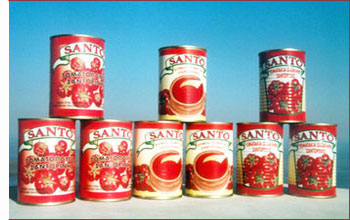
This tomato species was a rather late arrival on the island, first introduced in 1850. The old folks on Santorini actually claim that the seeds of it originated from the Suez Canal, where Greek sailors tasted the fruit and liked it so much that they decided to bring seeds back to Santorini.
The cherry tomato is small, bright red in color and slightly flat on the sides, with an acescent taste. Its size resembles the one of a cherry, hence the name. It's a sweet and mildly sour fruit.
Currently, cherry tomatoes are cultivated only in limited garden patches, while the output is standardized by the local Agricultural Association and the "Pavlo-Petrou Economou Co."

These tomatoes are seeded by the end of February and the seedings are thinned in April. Consequently, they are transplanted and the fruit is collected by mid-June.
If you visit Santorini, you should definitely taste the tomato-balls (pseftokeftedes) which are made from the mashed flesh of this fruit.
Now, if you go to Santorini and you want to find these products, there's one place where you're more likely to and that's "Iliotropio" on the country road of Firon-Pirgou.





